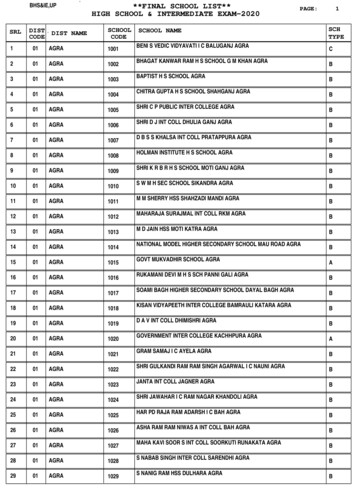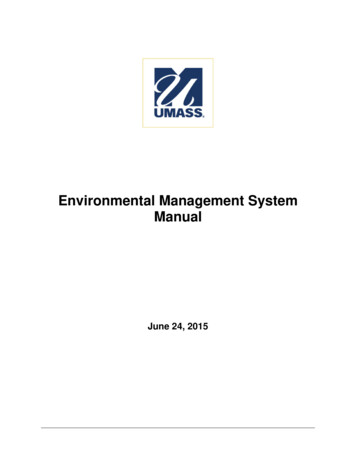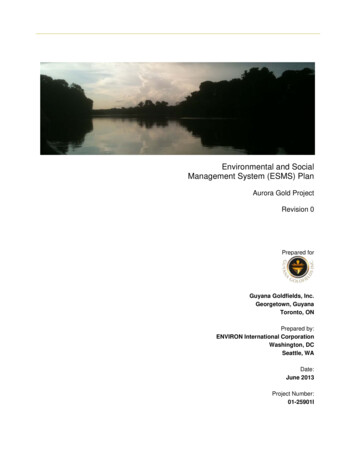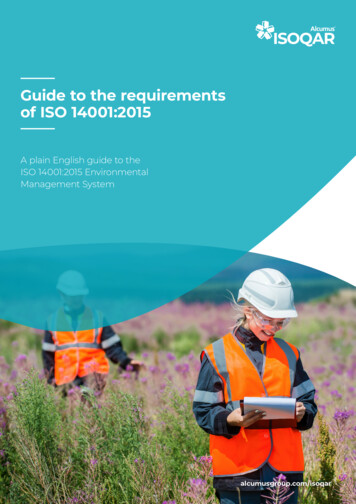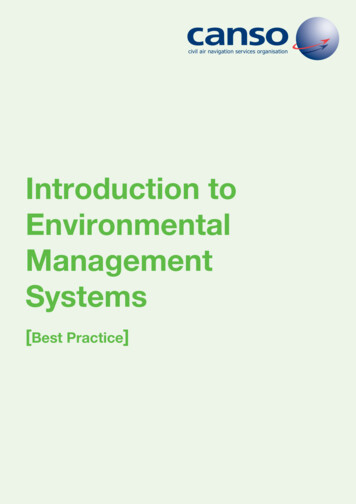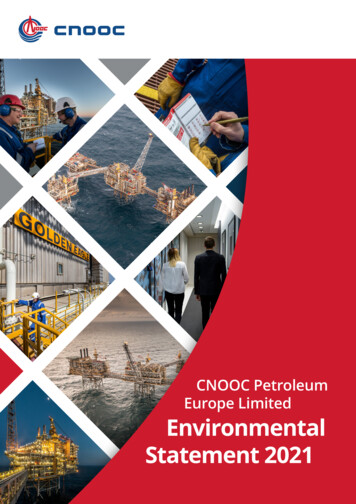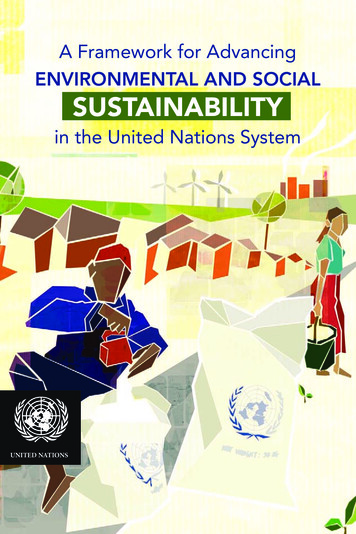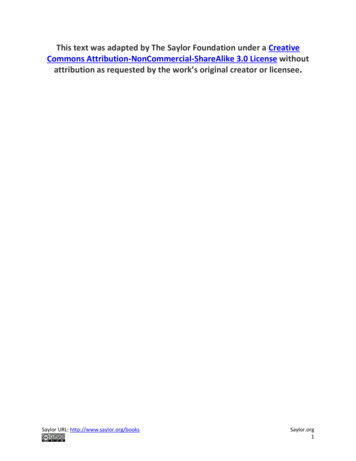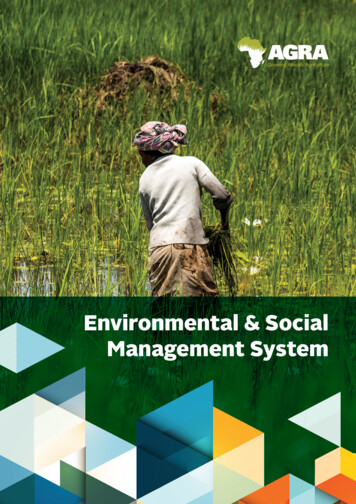
Transcription
Environmental & SocialManagement System1
ENVIRONMENTAL & SOCIAL MANAGEMENT SYSTEM2
ENVIRONMENTAL & SOCIAL MANAGEMENT SYSTEM1. Environmental And Social Management Policy1.1 MissionAlliance for a Green Revolution in Africa (AGRA) recognises environmental and social (E&S) riskmanagement as a critical issue that requires systems to monitor and control in line with legal and applicableinternational requirements in its operational sectors. This E&S Policy delineates AGRA’s vision andcommitment to sustainable development and how it is fully integrated into AGRA’s core business processesand lays the foundation of the environmental and social management system (ESMS) that is put in practice.1.2 GoalAGRA is committed to promote sustainable agricultural practices in its focus countries. As anenvironmentally informed and socially responsible organisation, AGRA is committed to avoid or mitigateadverse E&S impacts, if any, of its interventions.AGRA is committed in promoting the use of an appropriate ESMS in order to improve the management ofthe E&S implications of all of its funded projects and activities.1.3 Guiding principlesIn implementing this E&S Policy, AGRA shall adhere to a set of guiding principles as listed below: Avoid, reduce or limit negative environmental, social and climate impacts and improve the E&S benefitsof its initiatives; Support the preservation and protection of biodiversity and sustainably manage natural resources; Avoid negative impacts on the living conditions, livelihoods and land tenure of communities; Ensure the health and safety at work of its own employees and require its subcontractors and partnersto implement measures to protect the health and safety of their employees at work; Condemn forced labour and child labour, prohibit discrimination, prohibit and combat harassment andsupport the freedom of association and the right to collective bargaining of workers; Comply with all relevant environmental, social, health and safety as well as land acquisition policies,laws and regulations of the countries of intervention and international standards.1.4 Implementation of E&S policy principlesAGRA will implement its E&S Policy through its ESMS and all other key institutional policies includingthe Safeguarding of Vulnerable Persons Policy, Ethics Policy and Partners Code of Conduct and ensurecompliance with the respective governing laws and regulations as well as international standards specifiedin the ESMS. AGRA’s ESMS is designed to guide its implementation of the E&S commitments contained inthis E&S Policy.In particular, AGRA will establish and maintain the following E&S operational requirements: Screen all projects requesting funding and activities by AGRA against AGRA’s Exclusion List ; Take informed grant-award decisions based on robust categorisation of projects according to E&S risklevels, ascertained through various types of review processing including screening, E&S due diligence(ESDD) and, if and where required commensurate with the scale of the Project and the Project risks,environmental and social impact assessment (ESIA); Clearly define roles and responsibilities of implementation of the E&S activities across the entireinstitution, as well as emphasise on management review and reporting procedures; Have measures in place to monitor compliance with all relevant E&S policies, laws, and regulations ofthe country/-ies of intervention through AGRA’s work; Continuously develop and improve institutional capacity to understand, assess and manage E&Simpacts and risks associated with AGRA’s interventions; Implement the ESMS to deliver the commitments under this Policy and to monitor compliance with thisPolicy across its portfolio and periodically report to its management as well as collaborate and shareinformation with development partners and Project/programme beneficiaries. Communicate this Policy with employees, partners and other external stakeholders; Establish key identified partnerships with external stakeholders to manage E&S risks and work withpartners, employees and contractors to raise awareness of E&S management risks and, if identified, toensure that they are treated appropriately.3
ENVIRONMENTAL & SOCIAL MANAGEMENT SYSTEM2. AcknowledgementAGRA knowledges the financial and technical support from KfW. AGRA further recognizes the expertiseof the experts from Environmental Resource Management worked with AGRA teams to develop theenvironmental management system. AGRA acknowledges the overall partnership framework with BMZ formaking this work possible.4
ENVIRONMENTAL & SOCIAL MANAGEMENT SYSTEMContents1Environmental And Social Management Policy21.1Mission21.2Goal21.3Guiding Principles21.4Implementation Of E&S Policy Principles22Acknowledgement43Glossary Of Terms74Introduction104.1Overview Of Alliance For A Green Revolution In Africa (Agra)104.2Esms Structure104.3Applicable Environmental And Social Standards And Guidelines115Identification Of E&S Risk And Impacts135.1Potential E&S Risks Inherent To Agra’s Interventions135.2E&S Risks In Agra’s Grant Management Process176Esms Management & Organisation186.1Overview Of Agra’s E&S Organisational Structure186.2E&S Roles And Responsibilities186.3Developing E&S Capacity Within Agra217Esms Management And Monitoring227.1Management Of Potential E&S Risks At Country Level227.2Management Of E&S Risks At Grant Level228Esms Screening248.1Purpose Of The Esms Screening24Procedure For Esms Screening248.3Climate Mitigation And Adaptation Screening249Environmental And Social Impact Assessment (Esia)279.1Purpose Of An Esia275
ENVIRONMENTAL & SOCIAL MANAGEMENT SYSTEMFinal Reporting And Close Out3211Stakeholder Engagement3311.1Stakeholder Engagement Plan (Sep)33Grievance Mechanism3312Collaboration, Information Sharing And Reporting3613Esms Review3714Annexes386
ENVIRONMENTAL & SOCIAL MANAGEMENT SYSTEM3.Glossary of TermsAcronymTermAGRAAlliance for a Green Revolution in AfricaAPOAssociate Program OfficerEHSEnvironment Health and SafetyE&SEnvironmental & SocialESAPEnvironmental & Social Action PlanESDDEnvironmental & Social Due DiligenceESIAEnvironmental & Social Impact AssessmentESMSEnvironmental & Social Management SystemH&SHealth and SafetyIFCInternational Finance CorporationILOInternational Labour OrganisationKfWKreditanstalt für Wiederaufbau (German Credit Institute for Reconstruction)POProgram OfficerPSPerformance Standard of IFCPS1Performance Standard 1SEPStakeholder Engagement PlanWBGWorld Bank Group7
ENVIRONMENTAL & SOCIAL MANAGEMENT SYSTEMList of AnnexesAnnex 1:Strategic E&S Risk AssessmentAnnex 2:Capacity Building and Training PlanAnnex 3:AGRA Exclusion ListAnnex 4:Initial E&S Screening ChecklistAnnex 5:E&S Categorisation GuidelineAnnex 6:Template for a Request for Concept NotesAnnex 7:AGRA Project Proposal Submission GuidelinesAnnex 8:Capacity Assessment & Pre-Funding Site ChecklistAnnex 9:E&S Risk Assessment ToolkitAnnex 10:Grant Agreement LetterAnnex 11:Grant Commitment ChecklistAnnex 12:E&S Monitoring ChecklistAnnex 13:Template for an E&S Monitoring ReportAnnex 14:Template for an E&S Performance ReportAnnex 15:AGRA’s Enterprise Risk Management Framework (ERMF)8
ENVIRONMENTAL & SOCIAL MANAGEMENT SYSTEMDefinitionsTermMeaningEHS GuidelinesWorld Bank Group Environmental Health and Safety Guidelines.Environmental andSocial (E&S)For the sake of simplicity, the acronym E&S is used throughout this document,but the E&S Management System is developed to address all aspects of“sustainability”, as encompassed by the IFC Performance Standards, i.e.environment, social, health and safety, human rights and labour aspects.Environmental &Social Action Plan(ESAP)A plan that proposes measures to manage aspects identified in the ESDD toacceptable levels in line with the requirements of AGRA and its funding partners.Environmental &An assessment and analysis of environmental and social risks and opportunitiesSocial Due Diligence associated with a Project to ensure that such risks would not present a potential(ESDD)liability to AGRA.Environmental& Social ImpactAssessment (ESIA)The process of identifying, predicting, evaluating and mitigating the biophysical,social, and other relevant effects of Project proposals prior to major decisionsbeing taken and commitments made.Environmental &Social ManagementSystem (ESMS)The ESMS is the set of policies, procedures, tools and internal capacity at AGRAto identify and manage the environmental and social risks posed by the fundedinterventions.Excluded ActivityAny business or activity listed on the AGRA Exclusion List (cf. Annex 3).FinancialContributionAGRA receives financial contributions that are charitable in nature from variousinstitutions/funding partners.GrantA financial contribution issued from AGRA to a grantee (either a singleorganisation or a consortium of organisations) following a Project proposalsubmitted by the grantee/consortium.GranteeAn organisation, agency, government institution, non-profit entity, farmerorganisation or private company that receives funding from AGRA.InterventionUmbrella term to describe activities undertaken by AGRA to achieve its missionto promote inclusive agricultural transformation in Africa and improve the lives ofsmallholder farmers and their households in Africa.Legal RegisterA compilation of applicable legislations.MustMust is used to show that it is necessary or very important that somethinghappens in the present or futureProjectProjects are interventions implemented directly by AGRA or through Granteesand/or consortia of Grantees that are financed through grants provided by AGRAwith the aim of achieving AGRA’s mission.Shall‘Shall’ is used to indicate a requirement that is contractually binding, meaning itmust be implemented, and its implementation verified.9
ENVIRONMENTAL & SOCIAL MANAGEMENT SYSTEMShould‘Should’ is used to indicate a goal which must be addressed by the design team butWill‘Will’ is used to indicate a statement of fact. Will statements are not subject toverification.10
ENVIRONMENTAL & SOCIAL MANAGEMENT SYSTEM4. Introduction4.1 Overview of Alliance For A Green Revolution In Africa (AGRA)Alliance for a Green Revolution in Africa (AGRA) is an African-led non-for-profit organisation that seeksto promote an inclusive agricultural transformation on the African continent. Founded in 2006, AGRA’smission is to improve the lives of smallholder farmers across Africa by significantly increasing yields andincomes.AGRA recognises that environmental and social (E&S) sustainability are central to the attainment ofdevelopment outcomes that are inclusive and equitable, hence the need to be mainstreamed into its coreactivities. AGRA’s ESMS has been developed to underpin its resolve to reduce and/or avoid negative E&Simpacts as a result of its work and to ensure sustainable development outcomes.AGRA uses a range of interventions in differing forms to impact agriculture value chains in focus countriesto achieve its objectives. AGRA will therefore screen all its interventions for E&S risks both at a country andgrant level; and will define their management and monitoring as outlined within this ESMS. The objective ofthis ESMS is therefore to: Strengthen E&S outcomes Avoid negative impacts to people and their environment Manage, mitigate and minimise negative impacts Develop and strengthen AGRA’s and its partners’ capacities to manage E&S risks Develop and implement an effective stakeholder engagement.4.2 ESMS structureAGRA’s ESMS is designed to ensure that potential negative E&S impacts are minimised, while positiveeffects on communities and the environment are enhanced. It follows the guidance of International FinanceCorporation (IFC) Performance Standards (PS) on the assessment and management of E&S risks andimpacts, in particular, Performance Standard 1 (PS1) and international best practices. Relevant elementsof PS1 constitute the main building blocks of this ESMS. This ESMS includes: an E&S Policy and Manual,organisational capacities and competency needed, Stakeholder Engagement Plan (SEP) and a monitoringand review process.Figure 1.1shows the structure of AGRA’s ESMS, which reflects the integration of E&S assessmentsinto AGRA’s interventions. The ESMS Manual is structured along these elements and is focused on theallocation of grants and other programme implementation modalities as AGRA’s main instruments toachieve AGRA’s mission.Figure 1.1ESMS Structurewithin AGRA’sthree main areasof intervention11
ENVIRONMENTAL & SOCIAL MANAGEMENT SYSTEM4.3 Applicable environmental and social standards and guidelinesThe ESMS is premised on the following requirements: National environment, social, health, safety and labor laws and standards in the host countries of AGRAprojects, including requirements for public disclosure and engagement established therein. Relevant international law including conventions and treaties adopted by host countries. AGRA’s ESMS also benefits from policies and guidelines that set out international best practice such as:a. Sustainability Guidelines of KfW Development Bank (2019);b. IFC Environmental and Social Performance Standards (2012);c. World Bank Group’s General Environmental and Health and Safety (H&S) Guidelines (WBG EHSGuidelines);d. WBG Industry specific guidelines, as applicable (i.e. EHS Guidelines for Annual Crop Production,EHS Guidelines for Perennial Crop Production);e. Core labour standards of the International Labour Organisation (ILO);f. UN Basic principles and guidelines on development-based evictions and displacement;g. IFC Exclusion List for financial intermediaries of KfW;h. Voluntary guidelines on the responsible governance of tenure of land, fisheries and forests in thecontext of national food security (VGGT; FAO 2012);i. BMZ Reference framework for development partnerships in the agri-food sector (RFDP); andj. USAID – Pesticide evaluation report & safer use action plan (PERSUAP).Under the implementation of this ESMS, AGRA will review and evaluate all grant allocations against thesestandards.12
ENVIRONMENTAL & SOCIAL MANAGEMENT SYSTEM5. Identification of E&S risk and impacts5.1 Potential e&s risks inherent to AGRA’s interventionsAGRA engages in a number of interventions that promote its mission. These interventions have associatedE&S risks at an aggregated and/or country and regional level. Such interventions include, but are notlimited to support of: Promotion of an integrated package and agronomic practices; Development and adoption of improved crop varieties; Integrated soil fertility management e.g. use of fertilizers; Crop protection technologies e.g. pesticides; Support of agricultural extension services; Promotion of enabling policy environment; Promotion of postharvest management technologies; Gender equality Inclusive finance; and Access to markets.A list of potential E&S risks that result from the above mentioned interventions are identified and arepresented in the E&S risk assessment table below (Table.2.1). This E&S risk assessment serves as areference to be consulted during the assessment of E&S risks which are to be managed at the countrylevel.An E&S risk assessment shall be in place for each country of operation and updated periodically along withthe country plans and their accompanying risk registers. Measures identified to manage these risks shall bereflected within the risk register and implementation monitored through the annual project and countryprogress review process.Table 2.1: Key E&S Risks at the grant levelKey risk areasDescription of riskOverall E&S ManagementE&S Governance andManagement SystemsInadequacy of the approach and experience/ competency of the grantee/consortium to manage and budget for E&S-related issues can have an impacton the regulatory compliance and E&S performance.EnvironmentSoil Conservation andManagementPhysical and chemical degradation of soils (may result from unsuitablemanagement techniques, extensive tillage from use of inappropriatemachinery, poor crop/soil cover, etc.).Chemical degradation of soils (may result from insufficient or inappropriateuse of mineral fertilizers, etc.). Destruction of soil physico-chemical propertiescontributes to disruption of soil microorganisms which play an essential rolein decomposing organic matter, cycling nutrients and fertilising the soilSoil erosion and generation of sediments can be a significant pollutantdependant on the physical and chemical properties.Soil NutrientManagementNutrient management strategies aimed at maintaining and/or improving soilfertility to optimize crop yield could have off-site environmental impact (e.g.,contamination of groundwater resources and eutrophication of surface waterresources from surface runoff and leaching of nutrients).13
ENVIRONMENTAL & SOCIAL MANAGEMENT SYSTEMCrop Residue and SolidWaste ManagementPoor crop residue management i.e., export/burning vs retention can lead toloss of soil organic matter, soil erosion and overall loss of nutrients. This has anegative impact on crop performance, soil quality and overall soil health.Poor solid waste management can pollute groundwaterWater ManagementInadequate water management for crop production could decrease wateravailability.Agrochemicals/Pesticides Use andManagementAgrochemicals/Pesticides use and potential contamination of soils, wildlife,human health, groundwater, or surface water resources caused by accidentalspills during the transfer, mixing, storage, and appropriate application ofagrochemicals/pesticides.Genetically ModifiedCropThe use of plants, which DNA has been modified using genetic engineeringmethods, can lead to possible cross-breeding with related crops, giving themadvantages over naturally occurring varieties and thus creating the possibilityof long-term ecosystem damage by GM crop usage.BiodiversityHabitat conversion or degradation, mono-cropping, introduction of invasivespecies and reduced quality and/or availability of priority ecosystem services.Improved crop varietiesThe use of improved crop varieties may cause a reduction of local cropgenetic diversity. This may present negative impacts in the event of anepidemic, new disease or ability to fight back climatic shocks.Air qualityAtmospheric emissions are primarily associated with emissions of combustionby-products—including carbon dioxide (CO2), sulfur dioxide (SO2), nitrogenoxide (NOx), and particulate matter (PM) —resulting from the operation ofmechanized equipment or from combustion by-products from the disposal ordestruction of crop residues or processing by-products.Greenhouse gasemissionsEmissions of greenhouse gas emissions resulting from the operation ofmechanised equipment, crop production, animal manure, over use ofnitrogen-based fertilizers, land-use conversion or from the disposal ordestruction of crop residues or processing.Occupational H&S and Labour ConditionPhysical hazardsOperational and workplace hazards (slips, trips, and falls).Machinery and vehicles accidents (vehicle collisions; vehicle and machineryroll-overs, etc.).Confined and restricted space (entry for processing bins and silos, productstorage bins, areas treated with agrochemicals/pesticides,).Exposure to organic dust: (threshing, handling, and storage of grain generatepotentially high concentrations of organic dust including particles from grain,fungi, and bacteria, as well as inorganic material).Risk of fire andexplosionFires resulting from the combustion of stored oil or crop residues, which canlead to a loss of property or cause possible injury to or fatality people.Biological hazardsContact with venomous animals, such as stinging insects, spiders, scorpions,snakes, disease vectors (e.g., mosquitoes, ticks), and with certain wild animals.14
ENVIRONMENTAL & SOCIAL MANAGEMENT SYSTEMChild and forced labourChild labour, i.e. when someone (a member of the family of the out-grower,or small-business owner) under the legal working age is employed and resultsin harm to the child by depriving the child of an education, is economicallyexploitative or is damaging to physical and mental development.Forced labour, i.e. any work or service not voluntarily performed that isexacted from an individual under threat of force or penalty.Vulnerable ordisadvantages PersonsThere are individuals or groups that will be disproportionally disadvantaged bythe intervention e.g. women, youth, disabled, ethnic groups, gender identity,sexual orientation etc.Community H&SH&S ManagementLand use changes or to the loss of natural buffer areas/ecosystem services(such as wetlands, mangroves, and upland forests that mitigate the effectsof natural hazards, such as flooding, landslides, and fire) due to expansion ofagricultural land into natural areas and/ or land degradation through poorfarming practice.Potential exposure to agrochemicals/pesticides.Increased risk of vehicle or machinery injuries on roads.Land acquisitionLand acquisitionand InvoluntaryresettlementInvoluntary resettlement refers both to physical displacement (relocationor loss of shelter) and to economic displacement (access to resources forincome generation or means of livelihood) due to land acquisition (includingrights-of-way) associated with a Project’s operations.Inadequacy and appropriateness of the grantees’ approach to land acquisitionand to the extent relevant, stakeholder engagement (including grievancemanagement) on this issue, livelihood restoration and compensation mayresult in long-term hardship and impoverishment for Affected Communitiesand persons, as well as environmental damage and adverse socio-economicimpacts in areas to which they have been displaced.Stakeholder EngagementStakeholderengagement andgrievance managementLack of effective stakeholder engagement and grievance management.Stakeholder engagement is the basis for building strong, constructive, andresponsive relationships that are essential for the successful management ofa Project’s E&S impacts. Inadequate stakeholder engagement may not fullyaddress E&S impacts in a Project.If grievances are not addressed and recorded as part of the granteesstakeholder engagement activities, these grievances could be related toissues that could escalate into legal claims if unresolved.5.2 E&S risks in AGRA’s grant management processGrants awarded by AGRA vary in nature, number of partners, geographical coverage and amount. PotentialAGRA Grantees include among others: Governments and public sector organisations e.g. the Ministry of Agriculture; Ministry of Policy &Planning, regulatory bodies (seed, fertilizers and market), regional and continental institutions etc.;15
ENVIRONMENTAL & SOCIAL MANAGEMENT SYSTEM Not for Profit Organisations;Private sector organisations e.g. seed companies; processing companies; consulting companies;Universities and other educational institutions;Agro-dealers;Financial institutions;Farmers’ organisations;Marketing and farmer produce board e.g. grain councils; andResearch institutions.This ESMS describes a streamlined process of identification, assessment, management and monitoring ofE&S risks across the various types of grants and programme delivery mechanisms.An overview of the key E&S risks associated with AGRA’s activities at grant level are provided in Table 01Table 2 1. Although these E&S risks are not applicable to all grant activities they provide an overview ofpotential risks that may result from AGRA’s current Grants and other programme activities.16
ENVIRONMENTAL & SOCIAL MANAGEMENT SYSTEM6. ESMS management & organisation6.1 Overview of AGRA’s E&S organisational structurePresidentBoardChief of Staff& StrategyVice PresidentCountry support &deliveryVice PresidentChief of InternationalCooperation &Strategic InitiativesVice PresidentProgramme development& innovationPolicy & statecapabilityChief OperatingOfficerResilience: climate,Adaptation, Environmental& Social managementFigure 3.1: ESMS within AGRA Structure (01.2019)The Program Development and Innovation (PDI) Division will be responsible for managing all ESMS aspectsacross the organisation through a designated E&S Officer. The implementation and management of theESMS will follow existing/approved operational and management structures, processes and procedures,accountability and reporting as stipulated in AGRA’s governance and operational manuals.6.2 E&S roles and responsibilitiesThis section presents an outline of the roles and responsibilities within AGRA to successfully implementthe ESMS. As the ESMS evolves, AGRA will continuously assess required capacities within the organisationfor effective implementation. Table 3 1 provides an overview of the ESMS roles and responsibilities.Table 3.1: AGRA Staff Roles and Responsibilities for the Implementation of the ESMSRole/TitleResponsibility related to E&S ManagementBoard of DirectorsAGRA’s overall managing & governing organ, responsible for the overalloperationalisation of the ESMS.17
ENVIRONMENTAL & SOCIAL MANAGEMENT SYSTEMManagementPresidentAccountability for ensuring ESMS implementation, monitoring and reportingthroughout AGRA operations.Responsible for ensuring that country and regional operations havesufficient capacities and resources to implement the requirements of thisESMS.Responsible for monitoring performance at a country level, and complianceof all activities with ESMS requirements.Vice PresidentProgramDevelopment andInnovation (PDI)Responsible for ensuring the integration and compliance of ESMS acrossAGRA’s interventions.Responsible for the implementation of the ESMS, SEP and grievancemechanism in AGRA.ProgrammesE&S Officer(headquarter-based; 1person)Overall responsibility for ensuring compliance and management of E&Sissues/risks across AGRA.Manage resources (budget and staff) for E&S risk management proceduresLead, monitor and provide ongoing feedback to Country Managers on E&Stopics.Ensure the coordination and integration of E&S risk managementprocedures with AGRA’s Grant Cycle.Report any major E&S issues to the President and/or the Vice PresidentProgram Development and Innovation (PDI) and secure the support andapproval of E&S risk management issues by the President and/or the VicePresident Program Development and Innovation (PDI)Development/quality control of training materials for internal staff and forgrantees & Delivery of training on E&S to internal staff and grantees andmaintaining training records.Development/quality control of training materials for internal staff and forgrantees & Delivery of training on E&S to internal staff and grantees andmaintaining training records.Overall endorsements of E&S screening and assessments related to granteeapplications and proposals.Review and approval of AGRA’s annual E&S performance report tostakeholders (including lenders), E&S country assessments and action plans.Country Managers18
ENVIRONMENTAL & SOCIAL MANAGEMENT SYSTEM(Regional/countrylevel; 2 persons percountry)Overall responsibility for ensuring compliance and management of E&Sissues/risks on a regional/country level.Directly report and provide feedback on regional/country level bestpractices to the E&S Officer.E&S country risk assessments and update of the strategic risk assessmentfor the countries within the respective region.Reporting ‘red flag’ E&S issues to the E&S Officer.Lead, monitor and provide ongoing feedback to Program Officers (PO) andAssociate Program Officers (APO).Responsible for E&S assessments for grantee applications and proposals.Responsible for monitoring and evaluation of grantees on E&S performance(including review of monitoring reports).Support to the E&S Officer in delivering E&S training regionally and atcountry level to internal staff and externally to grantees.Program Officers (PO)/ Associate Program Officers (APO)(Regional/countrylevel)Conduct E&S assessments for grantee applications and proposals, includinginitial risk screening, review of concept notes and proposals, site visits, andE&S monitoring requirements in the grant agreement letter.Ensure that appropriate environmental representations, warranties, andcovenants are incorporated in each grant agreementSupervise portfolio grantees on-going compliance with the applicablerequirements on a regular basis, which may include:Conducting site visits, monitoring the implementation of E&S action plan(if any) by the grantees, reviewing grantees’ annual reports, and recordinggrantees’ E&S ongoing performanceResolving E&S issues in case of non-compliance, and where needed,preparing a time-bound corrective action plan with specific follow-upproceduresSupport to grantees in identifying E&S risks and developing mitigationmeasuresSupport to the E&S Officer and Country and Deputy Country Managers indelivering E&S training regionally and at country level to internal staff andexternally to grantees.Heads of Unit andProgramsEnsure that ESMS is integrated and implemented within their Interventions.GrantsHead of GrantsEnsure that E&S risk screening and assessments are included in the grantsmaking process.Ensure that E&S risk documentation is part of the grant review package andbeing considered in grant review processes and decisions.Grants CommitteeDiscuss and ensure that E&S risk assessment is included in the grantsmaking process.Determine the need for an Environmental and Social Impact Assessment(ESIA) subsequent to receiving the screening report.19
ENVIRONMENTAL & SOCIAL MANAGEMENT SYSTEMMonitoring and EvaluationHead of M&E UnitResponsible for ensuring that E&S risk monitoring is being undertaken inaccordance with the monitoring schedule.Provide oversight on country E&S risk assessments and monitoring.Support review of the ESMS policy as required.AGRA StaffSupport the implementation of ESMS in their various functions.6.3 Developing E&S capacity within AGRAAGRA will undertake ongoing awareness raising and training across the organisation, particularly for thoseresponsible and/or accountable for the implementation o
8 ENVIRONMENTAL & SOCIAL MANAGEMENT SYSTEM Annex 1: Strategic E&S Risk Assessment Annex 2: Capacity Building and Training Plan Annex 3: AGRA Exclusion List Annex 4: Initial E&S Screening Checklist Annex 5: E&S Categorisation Guideline Annex 6: Template for a Request for Concept Notes Annex 7: AGRA Project Proposal Submission Guidelines Annex 8: Capacity Assessment & Pre-Funding Site Checklist
